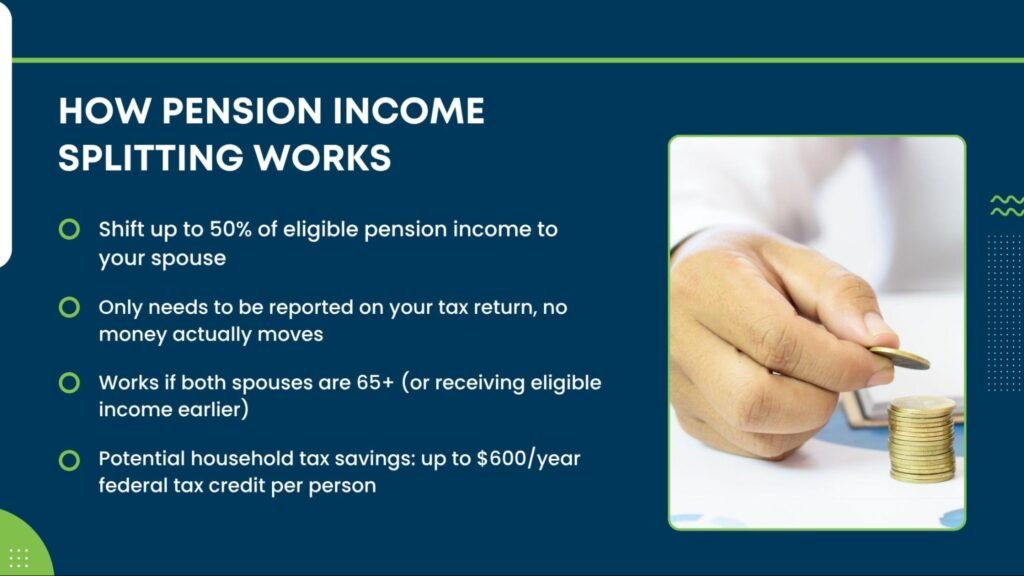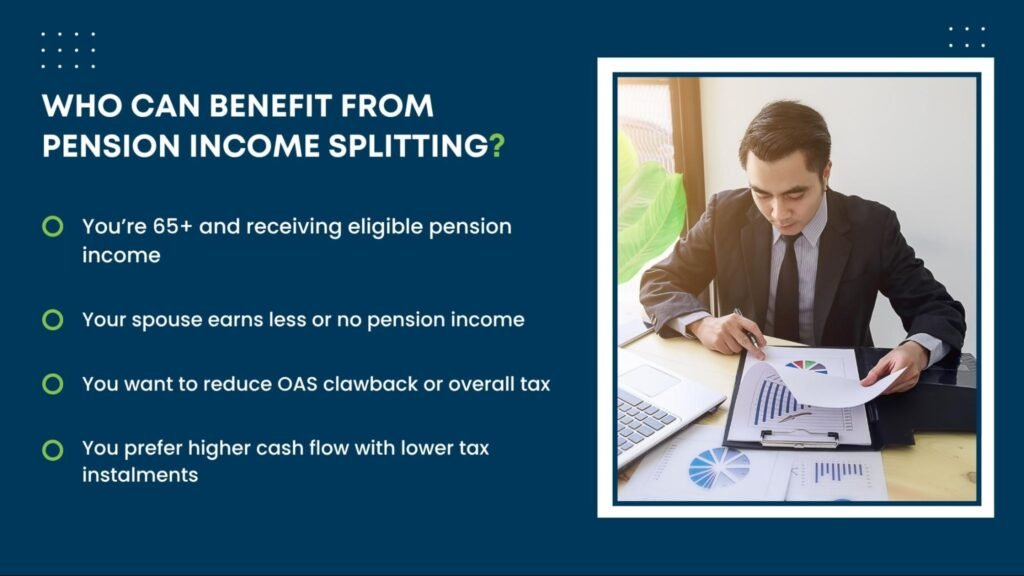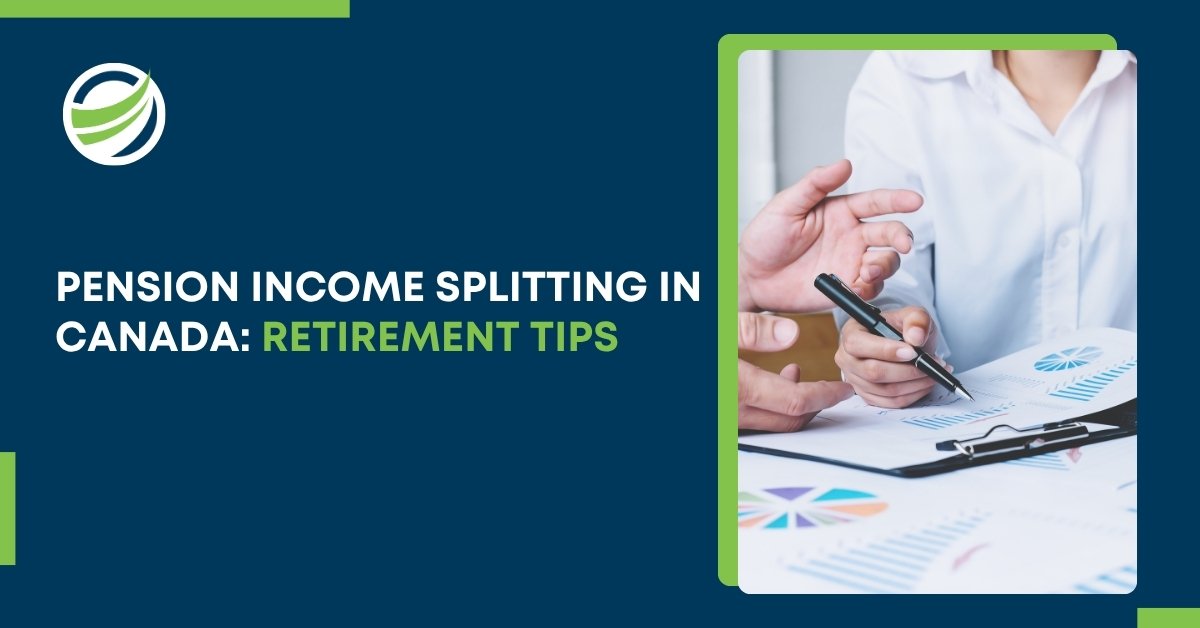Pension income splitting has become a powerful strategy for Canadian retirees in 2025 to maximise their after-tax income. It allows one spouse or common-law partner to transfer up to 50% of eligible pension income to the other, especially beneficial when there’s a noticeable gap between their incomes.
By exploring smart retirement tax strategies through trusted resources, couples can reduce their overall tax burden, retain more of their savings, and enjoy greater financial flexibility during their later years.
This method of retirement income splitting is not only straightforward but also highly effective in ensuring a more balanced tax outcome. For many Canadians, it serves as a critical pillar of tax-efficient retirement planning, especially when combined with other tools such as the pension income tax credit and Registered Retirement Income Funds (RRIFs).
With the right strategy, pension income splitting in Canada can lead to significant tax savings, ensuring that more of your income goes toward your lifestyle, not your tax bill.

What is Pension Income Splitting, and Who Can Benefit?
Pension income splitting enables Canadian couples to transfer up to 50% of eligible pension income from the higher-income spouse to the lower-income spouse, helping reduce overall household tax liability. This strategy helps reduce overall household tax liability, especially when one spouse is in a lower tax bracket.
The age of the pensioner (the one receiving the income) determines eligibility for pension income splitting. However, the age of the partner receiving the split income matters for claiming the pension income tax credit. Certain income types may qualify for pension income splitting Canada before age 65, offering planning opportunities for early retirees.
Pension Income Eligibility
To benefit from pension income splitting, the income must meet the criteria for eligible pension income under the Income Tax Act. Eligibility depends on the age of the pensioner at the end of the tax year.
If the Pensioner is Age 65 or Over:
Eligible pension income may include:
- The taxable portion of life annuity payments from a superannuation or pension plan
- Payments from a Registered Retirement Income Fund (RRIF), Life Income Fund (LIF), or Restricted Life Income Fund (RLIF), if the recipient is age 65 or older.
- Annuity payments from a Registered Retirement Savings Plan (RRSP) (note: regular RRSP withdrawals do not qualify)
- Annuity payments from a Deferred Profit Sharing Plan (DPSP)
- Pooled Registered Pension Plan (PRPP) payments
- Regular annuity contracts and Income-Averaging Annuity Contracts (IAAC)
- Qualifying amounts from a Retirement Compensation Arrangement (RCA)
- Certain payments from foreign pension plans, including U.S. Social Security
If the Pensioner is Under Age 65:
Eligible pension income may include:
- The taxable portion of life annuity payments from a superannuation or pension plan
- Payments listed above (e.g., RRIF, LIF, RRSP annuity) only if received due to the death of a spouse or partner
- Payments from certain foreign pension plans, including U.S. Social Security
Note: In Quebec, pension income splitting for provincial tax purposes is only allowed if the pensioner is age 65 or older at year-end.
Non-Eligible Pension Income
Not all retirement income is eligible for pension income splitting, only specific sources qualify under CRA rules. The following types of income are not considered eligible under the Income Tax Act:
- Canada Pension Plan (CPP) and Quebec Pension Plan (QPP) payments
- Old Age Security (OAS) benefits
- Guaranteed Income Supplement (GIS) payments
- Income from the U.S. Individual Retirement Account (IRA)
- Death benefits received after the passing of a plan member
- Retiring allowances, including severance pay
- RRSP withdrawals (unless they are annuity payments as previously noted)
- Transfers from a RRIF to another RRSP, RRIF, or annuity are not eligible for pension income splitting.
- Foreign-source pension income that is tax-exempt in Canada also does not qualify for splitting.
- Amounts received from a salary deferral arrangement
While Canada Pension Plan income splitting is not permitted under pension income splitting rules, CPP retirement benefits may be shared between spouses under a separate CPP sharing provision. This is a different program managed by Service Canada and should not be confused with tax-based pension income splitting.

How Pension Splitting Works
Each year, you and your partner can jointly file Form T1032 to split up to 50% of eligible pension income. The split is notional, no money changes hands, but your income is reallocated on your tax returns to reduce your overall tax burden.
If withholding tax was applied to the split income, a matching portion of that tax is also transferred to your partner’s return. Many tax software programs can calculate the optimal split, but it’s wise to consult a tax advisor for personalised guidance.
Spousal RRSPs and Early Income Splitting
Spousal RRSPs offer an additional way to achieve RRSP income splitting, especially for couples looking to balance income before age 65. Unlike standard pension income splitting, withdrawals from a spousal RRSP can provide early income-sharing opportunities, subject to attribution rules.
This strategy not only supports tax efficiency but also helps the lower-income partner build a separate retirement income stream, particularly useful since only up to 50% of eligible pension income can be split under the pension rules.
Pension Income Splitting – Key Planning Considerations
- Reduce OAS Clawback: Splitting income may keep both partners below the OAS clawback threshold.
- Affect on Tax Credits: It may reduce your taxes but increase your partner’s income, impacting their benefits.
- Tax Installments: It can lower your quarterly tax payments, but your partner may need to start theirs.
- Create Tax Credit: Your partner may become eligible for the pension income tax credit.
- Get Advice: Always consult a tax advisor to assess the impact on your specific situation.
Pension Income Tax Credit – Key Facts
- Federal Credit: Claim a non-refundable 15% tax credit on up to $2,000 of eligible pension income, equaling up to $300 in federal tax savings.
- Provincial Credit: Most provinces/territories (except Quebec) offer a similar credit, with amounts varying by region.
- Eligible Income: Generally aligns with pension income splitting sources but depends on your age.
- Under Age 65: Only specific income sources qualify (e.g., life annuities from a pension plan).
- Over Age 65: Broader eligibility for credit on most types of split pension income.
- Age Matters: The recipient’s age, not the pensioner’s, determines their eligibility to claim the credit.
- Non-Refundable: It reduces tax owed but won’t generate a refund if no tax is payable.
- Maximise Credit: Splitting $2,000 each, even in the same tax bracket, can let both partners claim the credit, doubling federal savings to $600, plus possible provincial credits.
RRSP Withdrawal Strategy to Maximise Pension Income Tax Credit
- Open a RRIF at age 65 to begin eligible pension income withdrawals.
- Transfer $14,000 from your RRSP to the RRIF
- Withdraw $2,000 annually from age 65 to 71
- Claim $2,000/year from RRIF to save $2,100 in federal tax over 7 years.
- Withdraw $4,000/year and split with a 65+ partner to double savings to $4,200.
Convert part of your RRSP to a RRIF at 65 and withdraw $2,000 yearly to claim the pension income tax credit, saving up to $2,100 in taxes over seven years, even without a traditional pension.
If you’re eligible for pension income splitting, your partner may also claim the credit, potentially increasing your household savings to $4,200, making this a smart and tax-efficient approach to retirement income planning.
Conclusion: Making the Most of Pension Income Splitting in 2025
In 2025, pension income splitting continues to be a powerful tax strategy for Canadian retirees looking to maximise their after-tax income and maintain financial stability. When combined with tools like spousal RRSPs, RRIF withdrawals, and the pension income tax credit, it offers meaningful opportunities to reduce household tax liability and enhance retirement income.
To ensure you benefit fully from the rules and avoid unintended consequences, it’s wise to consult an offshore tax Prep and custom the approach to your unique situation.
FAQ: Pension Income Splitting in Canada
- What income qualifies for income splitting?
Eligible income typically includes payments from Registered Pension Plans (RPPs), annuities from RRSPs and deferred profit-sharing plans, and after age 65, income from a RRIF, LIF, or RLIF. CPP and OAS are not eligible for pension income splitting, though CPP has its own sharing rules. - How does income splitting work in Canada?
Pension income splitting allows one spouse or common-law partner to allocate up to 50% of eligible pension income to the other on their tax return. This helps reduce the overall household tax burden, especially when there’s a large difference in incomes between the two partners. - Is pension income splitting a good idea?
Yes, for many retirees, it’s a smart tax-saving strategy. It can lower the higher earner’s tax rate, reduce OAS clawbacks, and help both partners access the pension income tax credit. However, the benefits vary by income level, age, and other sources of income. - When did Canada get rid of income splitting?
Canada phased out family income splitting for couples with children after the 2015 tax year. However, pension income splitting for retirees remains available and unchanged as of 2025. - What are the rules for splitting CPP?
CPP sharing is a separate program. Spouses or common-law partners can apply to share their CPP retirement pensions, based on the number of years they lived together while contributing to CPP. It requires a formal application to Service Canada and is subject to approval.





